The Multifort Patrimony Chronograph’s styling pays tribute to one of Mido’s oldest and most famous chronograph models: the Multichrono from 1937. The homage is immediately obvious whenever you look at the handsome dark blue dial and rose-gold bezel of this model from 2021.
Mido’s new version, our test watch, most closely resembles one of its historical ancestors with two counters at the 9 and the 3. Mido’s annals have this to say about the original chronograph: “The large central hand indicates the fifths of a second. The subdial on the right shows the elapsed time in minutes. This type of dial is recommended for athletes, technicians, photographers, etc.”
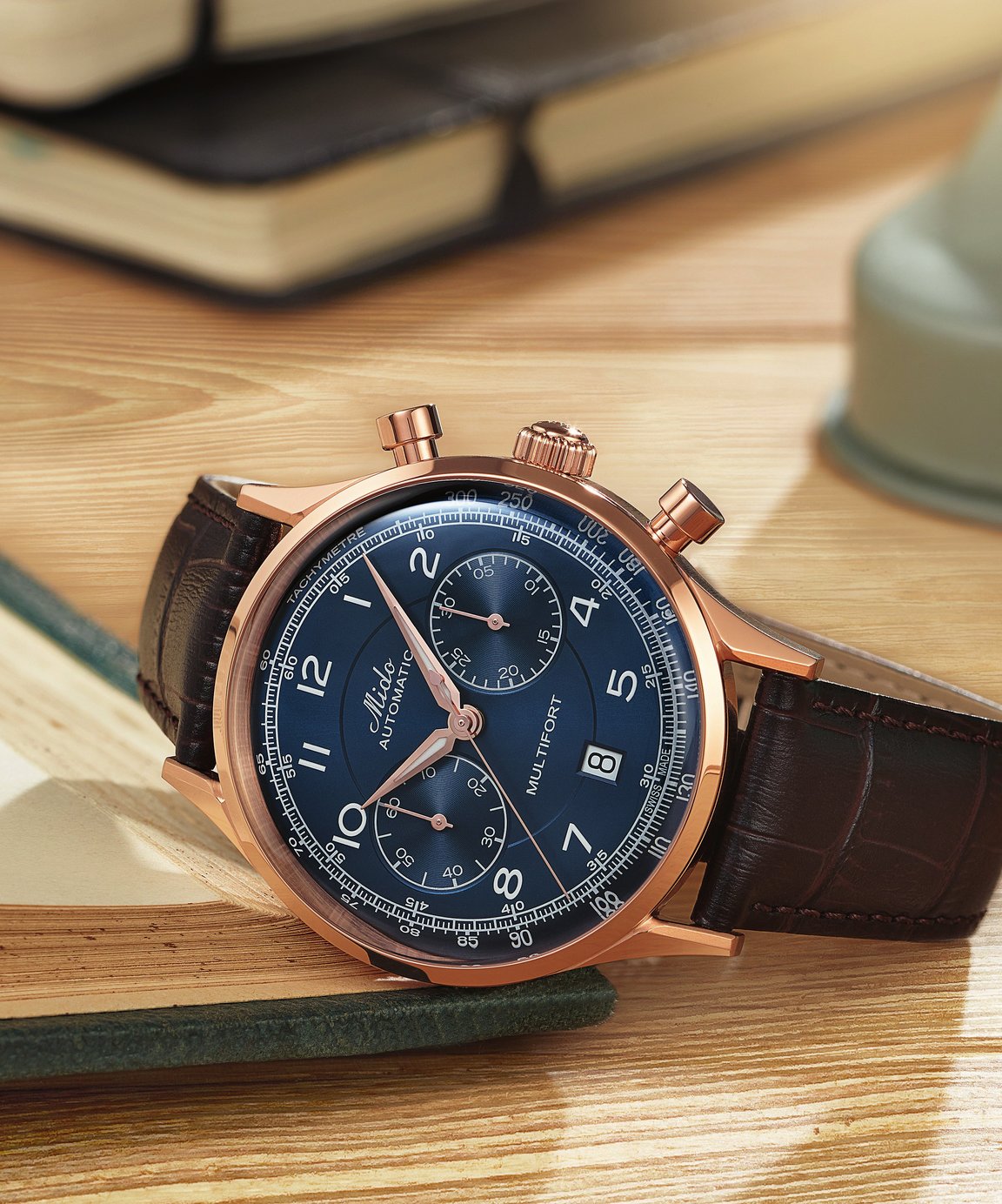
Speed Measurement Through The Years
Today, the new watch’s golden elapsed-seconds hand sweeps from the center of the dial, follows the 4-Hz rhythm of Mido’s modern Caliber 60 and passes smoothly along a correctly calibrated elapsed-seconds scale with three graduation marks per second on the edge of the dial. Together with the tachymeter scale, which is positioned even farther out on the dial’s rim, the elapsed-seconds scale gives the Multifort Patrimony Chronograph an instrument-like look. This tachymeter scale differs from those on historical models, which ran in a spiral in the inner part of the dial. Mido’s instruction manual explained how to use this scale: “At a distance of one kilometer, the reading is taken on three rings, beginning with the outer one. The numerals on the ring indicate the speed in kilometers per hour. The speed is read on the outer ring for an elapsed interval of less than one minute, on the middle ring during the second minute, and on the inner ring during the third minute.”
With our modern Multifort Patrimony Chronograph, only speeds of intervals up to one minute and 60 kilometers per hour can be read. But considering the fast pace of our times, this is probably not much of a shortcoming. Less satisfactory, however, is the fact that the tachymeter scale appears quite distorted under the highly arched rim of the box sapphire crystal and is, therefore, difficult to read. The suboptimum legibility here is quite the opposite of the clear readability of the rest of the chronograph functions and the time.
A Modern Movement Ticks Behind A Nostalgic Façade
Although the central elapsed-seconds hand is very thin, it can always be easily seen because its rose-gold color contrasts well against the dark blue background of the dial. The same good legibility also distinguishes the small and likewise gold-plated hand for the continually running seconds, its counterpart for the elapsed minutes and even more so for the two retro-style “alpha” hands for the main time, which even glow in the dark. The dial has a fine sunburst finish and the curvature of its rim follows the curve of the sapphire box crystal, thus emphasizing the nostalgic character of this timepiece.
The two chronograph pushers further affirm the handsome retro styling. With their mushroom shape, they look exactly the same today as their ancestors did on Mido’s first chronograph more than 80 years ago. Today, however, they trigger the stopwatch functions of a modern movement, namely the Mido Caliber 60, where the 60 in the name refers to the movement’s 60-hour power reserve. Caliber 60 embodies a modernization of the ETA/Valjoux 7753 to create the ETA A05.H31, which is also used in various versions by other brands of the Swatch Group, to which Mido also belongs.
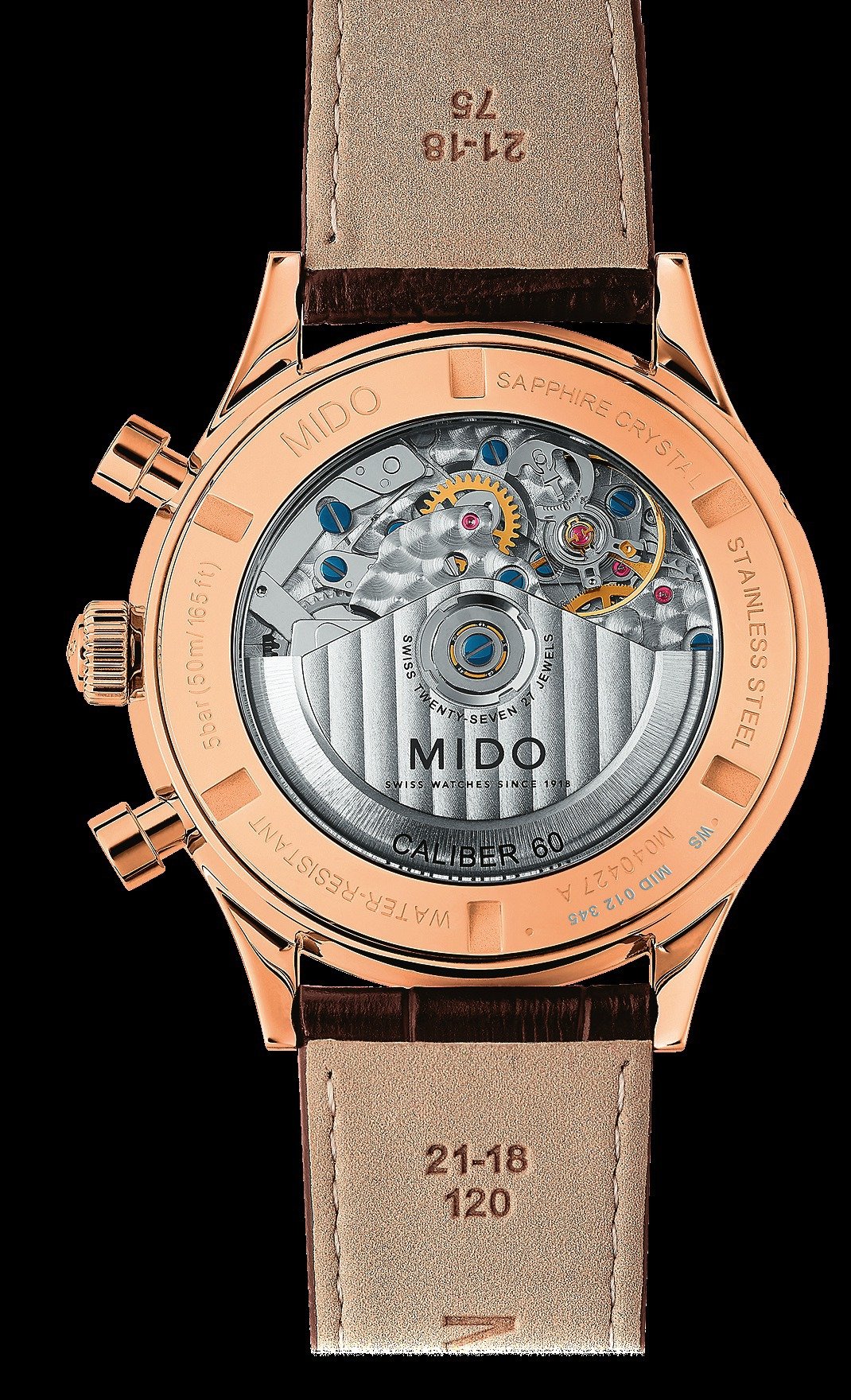
A relic from the ETA/Valjoux 7753 is the quickset date, which is positioned at the 6, where it replaces one of the classic white Arabic numerals. The quickset is not operated with the crown extracted to its center position, as is usual, but by pressing a tiny button inset into the case at the 10. The resetting requires a tool, a correction pen that is supplied by Mido, but which may not always be at hand.
Mido encases the Elaboré version of Caliber 60 in the Multifort Patrimony Chronograph. Among other things, this means that the movement is only regulated in three positions. ETA specifies a rate deviation of between plus and minus 7 seconds per day in this quality level. Our test watch kept time within this range in all situations. It ran best on the wrist, and its rate also remained stable with the chronograph switched on. The cam shift mechanism for the chronograph works in the usual manner. A bit more pressure is needed to begin measuring an elapsing interval; stopping, restarting and the zero position work a bit more easily. But these three commands run very pleasantly and give you the feeling of having secure pressure points under your fingertips. The partly polished and partly satin-finished case, which is plated with rose-gold PVD, tapers toward the back with a concave step, making it easier to turn the crown when resetting the hands. This also hides somewhat the overall height of more than 15.5 mm, which is due to the combination of the highly arching box sapphire crystal and the tall threaded back with its window of sapphire crystal.
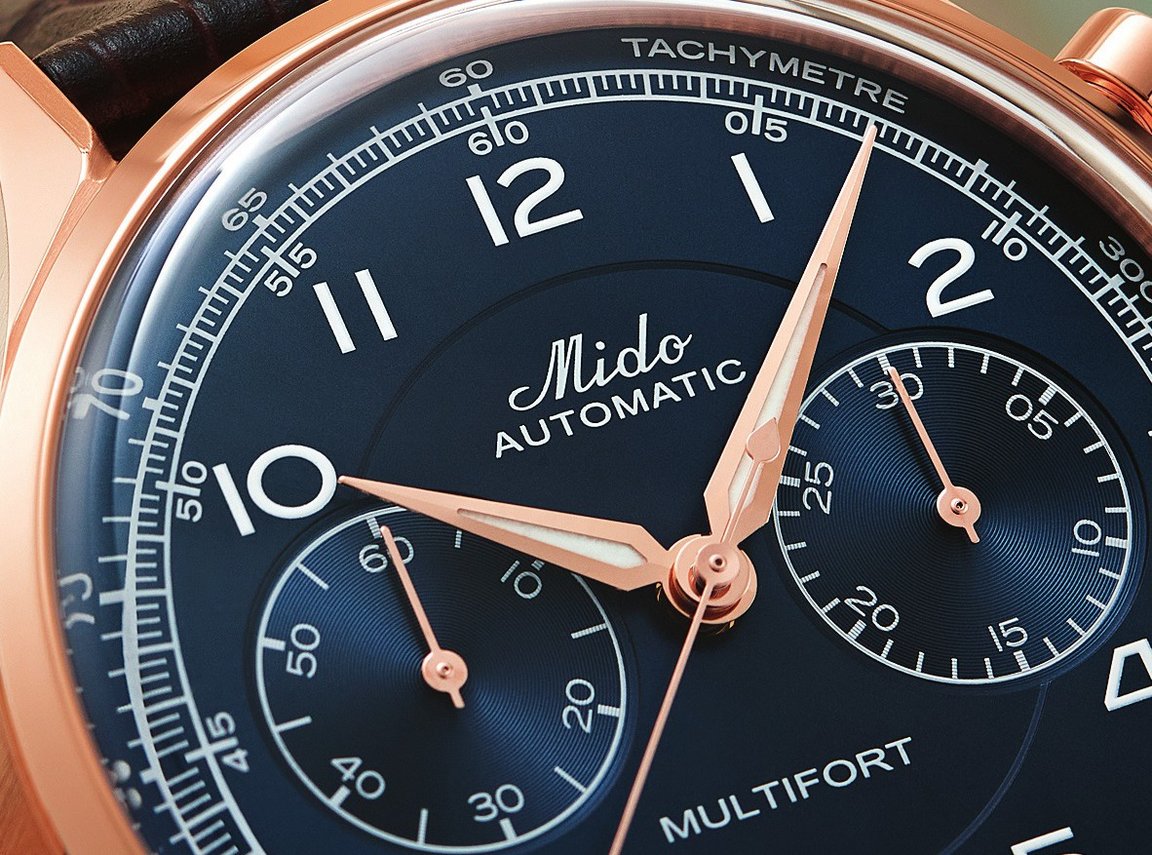
Historical Lettering Pays Tribute To a Rich Heritage
Despite its relatively tall height, the elegant yet sporty Multifort Patrimony Chronograph sits very well on the wrist. This is due to the highquality strap made of genuine Vachetta leather with faux crocodile embossing. The strap is crafted from thin cowhide and seems somewhat dainty, but the rembording toward the lugs assures that it is strong enough to securely hold the chronograph on the wrist. In keeping with the retro character of this watch, the leather strap is secured by a pin buckle plated with rose gold. And as on the dial below the 12, historical lettering on the buckle pays tribute to the heritage of both the timepiece and the Mido brand.
Mido Multifort Patrimony Chronograph Specs:
Manufacturer: Mido SA, Chemin de Tourelles 17, 2400 Le Locle, Switzerland
Reference number: M040.427.36.042.00
Functions: Hours, minutes, seconds subdial, chronograph (central elapsed-seconds hand, counter for 30 elapsed mintues), tachymeter scale, date
Movement: Mido Caliber 60, Elabore ́ , base ETA A05.H31, automatic, 28,800 vph, 27 jewels, gold-plated nickel balance, Nivarox 2 hairspring, fine adjustment via bipartite index, Nivachoc shock absorption, 60-hour power reserve, diameter = 30.0 mm, height = 7.90 mm
Case: Stainless-steel and rose-gold PVD, box sapphire crystal above dial, sapphire crystal in back, water resistant to 50 m
Strap and clasp: Vacetta leather with faux crocodile embossing, rose-gold PVD pin buckle
Rate results: Deviation in seconds per 24 hours (Fully wound / after 24 hours)
Dimensions: Diameter = 41.89 mm, lug width = 21 mm, height = 15.54 mm, weight = 96 g
Variations: With white dial (Ref. M040.427.36.262.00, $2,390); with black dial and stainless-steel case (Ref. M040.427.16.052.00, $2,160)
Price: $2,390
Score:
Strap and clasp (max. 10 points): Very handsome, high-quality strap matches the watch’s style, as does the clasp. 9
Case (10): The high-quality case suits the retro style and is well built, but quite tall. 8
Dial and hands (10): The elegant dial and retro hands match the watch’s style and the color of its case. 8
Design (15): The retro style is upheld very consistently in the case, dial, crystal, hands, pushers, strap, clasp, etc. 14
Legibility (5): The time and the chronograph function are quite legible during the day, but the tachymeter scale appears distorted; nighttime readability is limited. 4
Operation (5): The buttons and crown are easy to operate, but the date quickset requires the use of a tool. 4
Wearing comfort (5): Despite the tall height of the case, wearing comfort is good due to the well-crafted leather strap. 4
Movement (20): Modified ETA caliber in Elaboré quality with an increased power reserve. 15
Rate results (10): The rate is well balanced and doesn’t stray beyond the permissible deviations of the Elaboré quality level. 7
Overall value (10): A well-made, authentic watch offering a very good price performance ratio. 9
TOTAL: 82 points
To learn more about Mido, click here, and to subscribe to the WatchTime print magazine, click here.

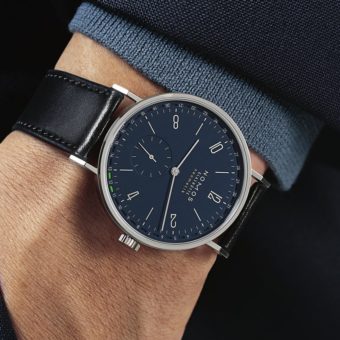


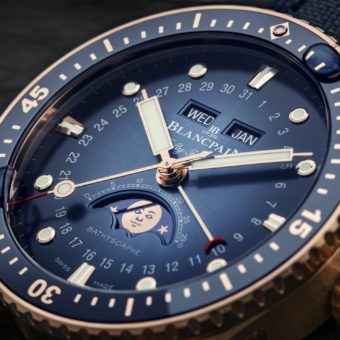
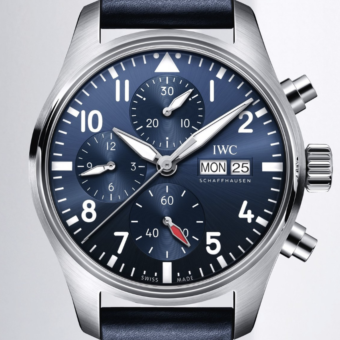
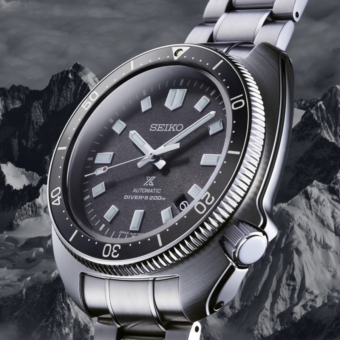
A lot of higher priced established brands as well as microbrands would be well served by taking cues from this brand’s design and style makeup, from its layout to its handset, to the entire package, not the least of which is its price. This watch and brand flies under the radar, while higher priced brand examples could learn a lesson here. But they won’t. Too bad. They should!
I don’t know how you came up with the pricing you did, but it’s wrong! For the model watch you’re reviewing it’s $2,500, not the $2,390 price you show.
Love this piece but why reference “Patrimony” in the name?
I can see a legal case pending with Vacheron …..
Such a shambles to even think that Mido could even go there …